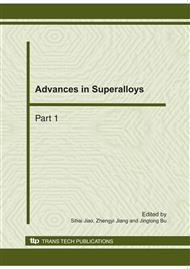p.1458
p.1463
p.1469
p.1473
p.1477
p.1482
p.1486
p.1491
p.1498
Property of Cu-Zr-Ti Ternary Alloys
Abstract:
The influence of Zr on the property of Cu(50+x)Zr(40-x)Ti10 (0≤x≤30 at.%) alloys were investigated. The results show that the maximum size for the glass formation in this Cu-Zr-Ti system is less than 8 mm. The hardness increases with decreasing of the Zr content, then decreases when the Zr content exceeds 10~15 at.% due to the obvious alteration of the type of the crystalline phases and the microstructure. With decreasing of the Zr content, the transformation sequence of the main Cu-Zr phase is Cu10Zr7→Cu5Zr→Cu51Zr14; the transformation sequence of Cu-Ti phase is Cu4Ti3→CuTi→CuTi3. In addition, the atom ratio of Cu60Zr30Ti10 alloys is coherent with that of their corresponding crystalline phase, resulting in its better glass forming ability.
Info:
Periodical:
Pages:
1477-1481
Citation:
Online since:
October 2010
Authors:
Keywords:
Price:
Сopyright:
© 2011 Trans Tech Publications Ltd. All Rights Reserved
Share:
Citation:


